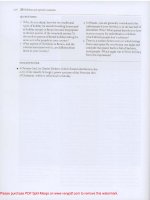Tài liệu Thesis Guidelines doc
Bạn đang xem bản rút gọn của tài liệu. Xem và tải ngay bản đầy đủ của tài liệu tại đây (155.8 KB, 5 trang )
Thesis Guidelines
NỘI DUNG
• Preparation of thesis - Chuẩn bị cho viết luận văn.
• Typical timetable - Mẫu thời gian tham khảo hữu ích.
• Literature review - Khái quát và tổng kết lý thuyết.
• How to get a Ph.D - Làm thế nào để hoàn thành 1 luận văn tiến sỹ.
Preparation of thesis
Notes on Preparation of CPGS and Ph.D. theses H. K. D. H. Bhadeshia
• The supervisor will read only two drafts: the first of individual chapters, and the
second of the complete thesis. Consequently, do not submit revised chapters until
the complete thesis draft is ready.
• A careful and COMPLETE first draft will lead to rapid progress. Get someone to
proof read your work before submission to the supervisor. The supervisor can then
focus on the science instead of trivial mistakes.
• Drafts should be submitted in double line spacing to allow space for comments.
• Style and presentation are important but the contents really matter.
• Computer programs should be presented in the MAP format.
• Publication of work is a good thing before writing a thesis. A paper, when
incorporated into a thesis, must be modified to ensure continuity and context. It
should be readable and gentle in its introduction compared with a journal paper.
Better English
• Avoid frequent repitition of words or phrases. To specify a rotation, one rotation
axis is not enough; the sense of rotation must be specified. can be expressed better
by writing The transformation also requires a specification of the sense of rotation.
• Avoid being personal. Let us look at an example…. is expressed better as Consider
an example…. The phrase We can also use a single row… can be written A single
row…. can also be used
• Text making an excessive use of abbreviations lacks clarity.
Common Mistakes
1. No excuse for spelling mistakes - use SPELLCHECK.
2. Inconsistency of notation. The thesis must share a common terminology, best
ensured by using a nomenclature list.
3. There should be a gap after a full stop or a comma. Accredited abbreviations found
in the Oxford English Dictionary (such as Ph.D.) do not have gaps after full stops;
initials in names must be separated by spaces (A. N. Other).
4. There are no spaces after an opening bracket or before a closing bracket
5. Include titles in the reference list.
6. Inadequate referencing.
7. Left quotation marks are not the same as right quotation in TeX.
8. There is a thin-space between numerals and units (e.g. 45 MPa). The units
themselves are in roman font. Use strict SI convention. For example, there is a gap
between MN and mm when writing MN mm. Use exponents: MN mm
-1
rather than
MN/mm
9. Incorrect or unspecified units of concentration: Fe-10Ni % is not good enough. e.g.,
use Fe-10Ni wt%.
10. Experiments are reported in the past tense. For example, length changes were
analysed.
11. Abbreviations must be explained when first introduced (HAZ, TTT ?!).
12. Fig. 4.2 not Fig.4.2; Table 5.1 not Table.5.1
13. Terms like “Fig. 4.2″ should be on the same line
14. “Compared with” rather than “Compared to“.
15. Plural of Datum is Data. These data are excellent….
16. PROGRAMME of work as opposed to computer PROGRAM
17. Names of chemical elements do not begin with capitals unless at the beginning of a
sentence.
18. All equations, tables, figures must be numbered.
19. Figures must not be excessively large, and should be included in the text rather than
at the end of chapters. The font on scales and legends should be at least size 15
(Geneva) when the figure size is 1/3 of the page length.
20. It is wrong to write a volume fraction as 20%. The latter is a volume percent.
21. Mathematical notation is in italics whether it occurs in the text or in equations.
Terms such as log, exp, sin are nevertheless in roman font even when in equations.
Mathematical notation in figures should be the same as in the text.
22. When presenting the results of computer programs, it is important to specify
completely the inputs used to generate the outputs. For example, it is dangerous to
present a calculated phase diagram without specifying all the phases and
components accounted for in the analysis.
23. ’software’ is plural. Avoid using ’softwares’.
Figures and Tables The notation on figures must correspond to that used in the text. There
must not be information on figures which is not discussed in the text. Units on diagrams
must be SI. Old diagrams with non-SI units must be redrawn. Any diagrams obtained from
the literature must be acknowledged even though they may have been redrawn, especially
if the intellectual content of the diagram is not significantly modified. Quantities plotted are
dimensionless, so they should be divided by the units on the axis legends (e.g., distance /
m). An example illustrating all the features is given below. In that figure, S
V
is a surface per
unit volume. ε
i
is a length.
Columns in tables should not be separated by vertical lines. The recommended practice is
to omit such lines for clarity:
Hints
1. Appropriate use of references:
o Use the Havard system to refer to articles in the text, as used in Progress in
Materials Science article, 1985, vol. 29, pp. 321-386.
o Try and put the reference at the end of the sentence in order to avoid
breaking continuity.
o Include article titles in your reference list.
o Do not abbreviate Journal titles, unless using the international standard set
of abbreviations (found in the Scientific Periodicals Library).
o In the reference list, quote the page range (e.g., 321-386).
2. Ensure that all the work you have done is included in your thesis; negative results
are also useful.
3. Do your writing as you progress, rather than leaving it to the last minute.
4. Micron markers should be placed on the micrographs, rather than on the page in the
vicinity of the micrograph.
5. Avoid the use of jargon. Your work should be comprehensible to others in the
Department. Examples of jargon: “recrystallisation region”, “TMCP”, “HAZ”.
6. Read and check your report at least twice before submission. The thesis must not
exceed, without the prior permission of the Degree Committee, 60,000 words,
including tables, footnotes, bibliography and appendices, but excluding
photographs and diagrams.
Results from Commercial Software Calculations using commercial software should be
presented with adequate detail to enable a reproduction of the results. For example, when
using MTDATA for phase diagram calculations, it is necessary to list the components and
phases allowed, together with the name and version number of the computer program and
database.
Microanalytical Data Data collected using energy-dispersive X-ray analysis or similar
techniques should be quoted with error bars and an indication whether ZAF (atomic
number, absorption, fluorescence) corrections have been made. The spatial resolution
should also be specified.
Typical timetable
This timetable for the preparation of a Ph.D. Thesis assumes that your interpretations are
well advanced and that no difficulties arise during the construction of an overall view. For
example, further experiments and interpretation might become necessary. Oversights like
these are natural in research but can be minimised by publishing papers during the course
of the work. Theses which are not completed according to the official deadline will always
have a lower priority from the supervisor.
Introduction 3 weeks
Method and results 6 weeks
Discussion, tables, figures, refs etc 6 weeks
Typing 2 weeks
Sub-total 1 17 weeks
Consultation with supervisor and others 1 week
Revision of draft 2 weeks
Sub-total 2 3 weeks
Final typing, art work on figures,proof reading etc. 3 weeks
Binding 1 week
Sub-total 3 4 weeks
TOTAL 24 WEEKS
Literature review
A good survey of the published literature can be thrilling:
1. It leads to an accumulation of knowledge, which is essential to reach the state of the
art.
2. It is possible to discover discrepancies which can help define new theories.
3. The survey minimises the danger of repeating research through ignorance of work
that has already been done.
4. Chance favours the prepared mind (Pasteur).
Literature surveys take time and require some discipline. They tend to gather momentum as
papers tend to refer to other relevant sources of information.
The discipline might be that you spend a couple of hours each day studying and writing.
Allocate a time when you are likely to be most alert, and stick to this, no matter how many
e-mail messages you might receive!
Deadlines are important, and you should plan your work so that your supervisor has
sufficient time to study the survey, suggest amendments or more references before the final
version has to be submitted.
Students starting in October should submit their final versions to their supervisors by the
end of March. It is good practice to get someone else to read the draft before submission to
your supervisor









